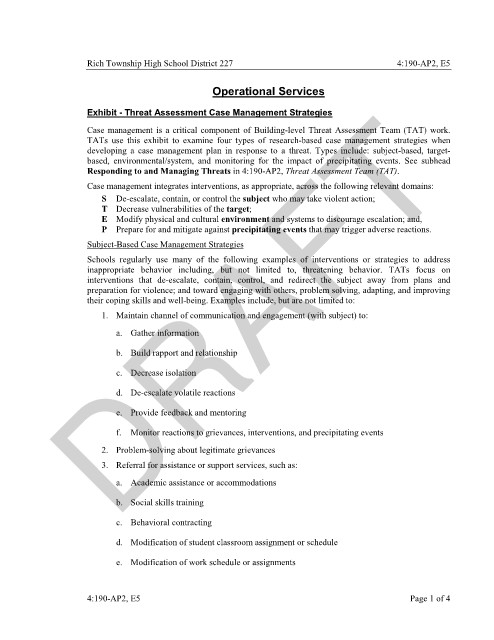Page 885 - draft
P. 885
Rich Township High School District 227 4:190-AP2, E5
Operational Services
DRAFT
Exhibit - Threat Assessment Case Management Strategies
Case management is a critical component of Building-level Threat Assessment Team (TAT) work.
TATs use this exhibit to examine four types of research-based case management strategies when
developing a case management plan in response to a threat. Types include: subject-based, target-
based, environmental/system, and monitoring for the impact of precipitating events. See subhead
Responding to and Managing Threats in 4:190-AP2, Threat Assessment Team (TAT).
Case management integrates interventions, as appropriate, across the following relevant domains:
S De-escalate, contain, or control the subject who may take violent action;
T Decrease vulnerabilities of the target;
E Modify physical and cultural environment and systems to discourage escalation; and,
P Prepare for and mitigate against precipitating events that may trigger adverse reactions.
Subject-Based Case Management Strategies
Schools regularly use many of the following examples of interventions or strategies to address
inappropriate behavior including, but not limited to, threatening behavior. TATs focus on
interventions that de-escalate, contain, control, and redirect the subject away from plans and
preparation for violence; and toward engaging with others, problem solving, adapting, and improving
their coping skills and well-being. Examples include, but are not limited to:
1. Maintain channel of communication and engagement (with subject) to:
a. Gather information
b. Build rapport and relationship
c. Decrease isolation
d. De-escalate volatile reactions
e. Provide feedback and mentoring
f. Monitor reactions to grievances, interventions, and precipitating events
2. Problem-solving about legitimate grievances
3. Referral for assistance or support services, such as:
a. Academic assistance or accommodations
b. Social skills training
c. Behavioral contracting
d. Modification of student classroom assignment or schedule
e. Modification of work schedule or assignments
4:190-AP2, E5 Page 1 of 4

